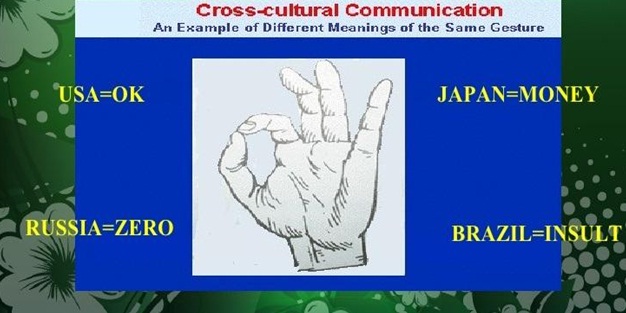Cross Cultural Communication
Cross-cultural communication has become strategically important to companies due to the growth of global business, technology, and the Internet. In today’s corporate world there is so much work force diversity which involves cultural speak, ways to Communicate, decision making style, approaches to knowing, values & beliefs, how people perceives the world around them, life style, languages, ethnicity etc.

So, Cross-cultural communication in an organization deals with understanding different business customs, beliefs and communication strategies. Language differences, high-context vs. low-context cultures, non-verbal differences, and power distance are major factors that can affect cross-cultural communication.
“Cultural differences should not separate us from each other, but rather cultural diversity brings a collective strength that can benefit all of humanity.” Also: “Intercultural dialogue is the best guarantee of a more peaceful, just and sustainable world.” -Mahnaz Afkhami
Factors that make cross cultural communication imperative:
- Globalization
Nowadays, every company is in the race to be an MNC. Post the globalization, this trend has been always increasing. It has opened the doors of great business & job opportunities. Globalization has also helped improve the contribution of employee in diverse workforce. The environment of sharing of views, ideas and talent improvisation has been some of other benefits of globalization. It requires cross border movement of people, goods and data bring more and more culture into contact with one another and increase the potential of cross cultural communication.
- High context Culture
It is the culture that relies heavily on non-verbal and subtle situational cues in communication. In this scenario, the chances of misunderstanding occur. To overcome such misunderstanding, cross culture communication training plays important role.
- Low Context Culture
Culture that rely heavily on words to convey meaning in communication. In this Scenario, the chance of conflict occurs because people will take a word according to their own language/culture. So, you have a chance to solve this conflict through cross cultural training or programs.
- Gesture
A motion of the hand, head or body emphasizes an idea of emotion. Gesture is mostly unique to the culture or society in which it develops.
When two people of different cultures encounter each other, they not only have different cultural backgrounds but their systems of turn – talking are also different. Cross cultural communication will be more effective and easier if both the speakers have knowledge of the turn taking system being used in the conversation (For example: One person should not monopolize the conversation or only one person should talk at a time).
Sources of Miscommunication in Cross Cultural Exchanges
- Assumption of similarities: This refers to our tendency to think how we behave and act is the universally accepted rule of behavior. When someone differs, we tend to have a negative view about them
- Language Differences: Problems occur when there is an inability to understand what the other is saying because different languages are being spoken.
- Nonverbal Misinterpretation: The way we dress, the way we express ourselves through our body language, eye contact and gestures also communicates a lot of things. A simple gesture like nodding the head is considered to be YES in certain cultures and NO in others.
- Preconceptions and Stereotypes: Stereotypes involves putting people into pre-defined slots based on our image of how we think they are or should be. It may consist of a set of characteristics that we assume that all members of a group share.
- Tendency to evaluate: Humans tend to make sense of the behavior and communication of others by analyzing them from one’s own cultural point of view without taking into consideration why the other person is behaving or communicating a certain way.
- High anxiety: Sometimes being confronted with a different cultural perspective will create an anxious state in an individual who does not know how to act or behave and what is considered to be appropriate
Strategies for Effective Cross-Cultural Communication within the Workplace
A productive workforce means creating an environment that supports diversity, while balancing the pressures of management, time and cost. There are many resources that provide communication tactics in a culturally diverse organization.
Simple tips to keep in mind when interacting and communicating with other people in your organization:-
- Keep an open mind and look for the gestures, signs.
- Have at least some knowledge of people cultural background
- Practice active listening
- Watch your nonverbal communication
- Maintain a personal touch
Cross Cultural Risk
- Ethnocentric orientation:- using our own culture as the standard for judging other cultures. One should refrain from using it a factor to decision making.
- Polycentric orientation:- A host country mindset where the manager develop the greater affinity with the country in which he or she conduct business
- Geocentric orientation:– A global mindset where the manager is able to understand a business or market without regards to country boundaries
Business is not a one day match
The essence of cross- cultural communication has more to do with releasing response than with sending messages. It is more important to release the right response than to send the right message






